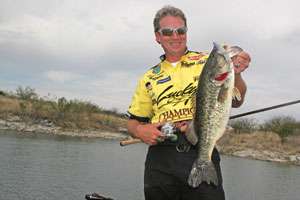
There are times when the secret to successful patterns is blowin' in the wind.
That was definitely the key to Skeet Reese staying with a school of quality bass during the Lake Amistad Elite Series Tournament in Texas earlier this year.
Reese spent his practice period during the prespawn period looking for giant bass on the massive Texas/Mexico border lake, and Amistad is full of them.
"The best big-fish pattern I could find was on the deep breaks leading into the creeks," he recalled. "The bass hadn't moved up to spawn, but they were staging on the deep stuff in anticipation of making that move."
Reese used a Lucky Craft Pointer 128 to jerk up a five fish limit weighing more than 25 pounds on the first day of competition, and he added another 21 pounds the second day to move into 16th place.
On the third day, his deep pattern was deteriorating quickly, producing only small fish. He found that puzzling since the weather patterns the third day were about the same as they were during the first day of the tournament.
"The water was clear and the weather was warming compared to what it had been in practice," he noted. "The quality of my deep fish was dropping. Conditions were changing, but I wasn't sure why."
He had a hunch the wind was a contributing factor. So he put his foot on his trolling motor and started following the wind toward a shallower strike zone.
"I just started exploring, moving shallower into the pockets near the places I'd been fishing," he explained.
"When I saw the [water] temperature on my Lowrance graph rise into the mid-60s, which was a lot warmer than I found in the shallows during practice, I began to understand what was going on."
The steady breeze, he surmised, was pushing warmer surface water into the creek and the fish were moving shallow along with it.
"I started seeing a lot of big fish and getting better bites," Reese described. "Those fish I had been catching 200 yards out on the ledge had moved up overnight."
From that point on, Reese began keying on windblown pockets along the shoreline. The pockets that were basically protected from the wind, he soon discovered, lacked the quality of fish he found in the ones that caught the brunt of the wind.
"In addition to having warmer water, the windblown pockets produced more aggressive fish than the calmer ones did," he observed.
"That's important to remember when fishing clear water. Key on the windier shallows and you'll get more bites."
Reese probed around brushpiles located in the exposed pockets with a Gulp! Sinking Minnow. His biggest fish came on a swimbait that he worked slowly through the openings in the cover.
The strategy produced a ninth place finish in the event. However, Reese now believes he would have probably fallen out of the Top 20 without making that subtle adjustment.
"It's not easy to abandon a pattern that has been working so well. But sometimes you have to take those risks," he offered.
"The wind didn't change directions or speed, but its [gradual] effect on the water and fish over a couple of days was huge.
"It's one I could have overlooked, so I'm glad I picked up on it."
